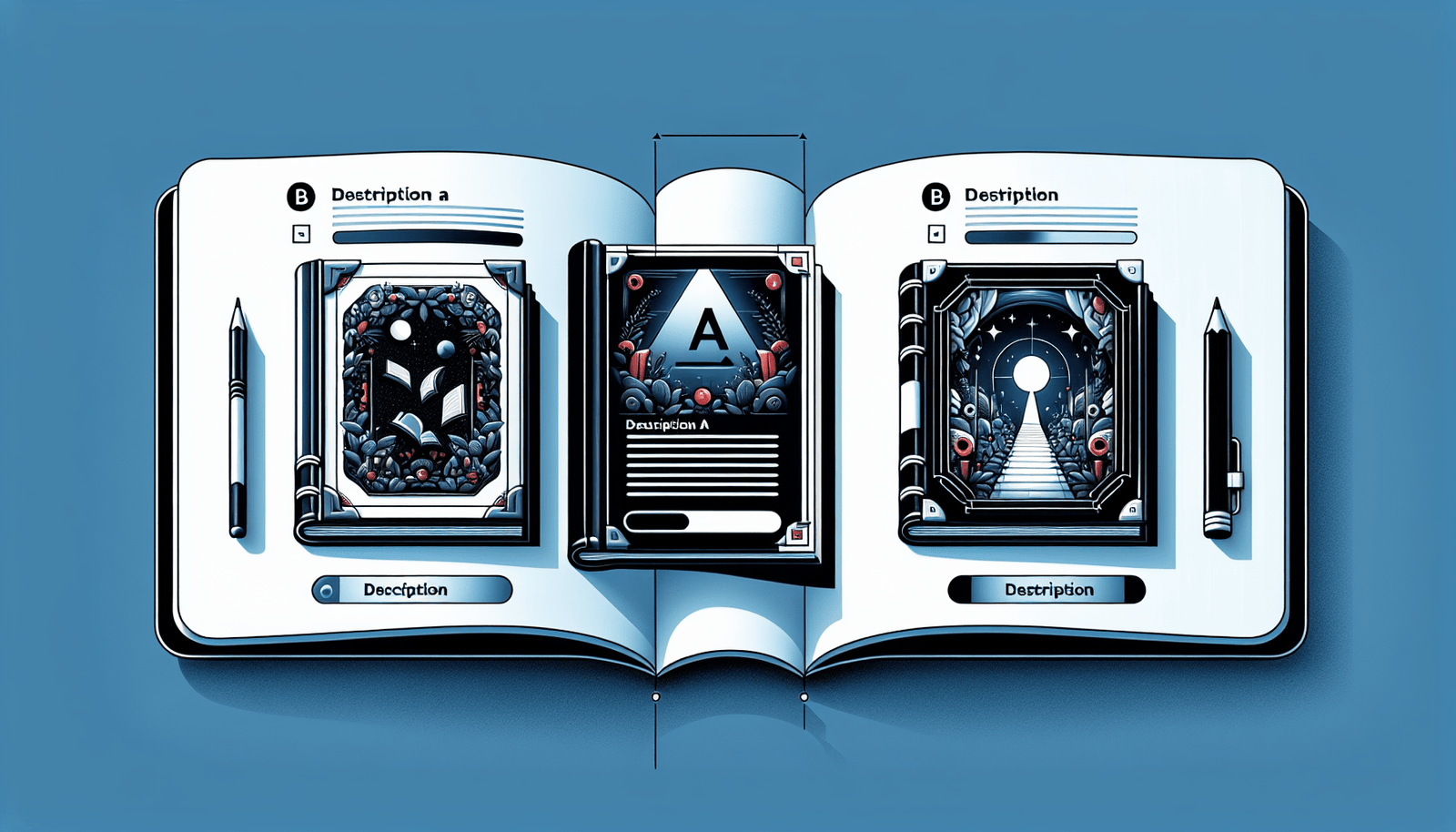Are you eager to elevate your book sales but aren’t sure where to begin? Dive into the world of A/B testing with this insightful guide on how to set up effective tests for your book descriptions. By comparing two different versions of your book’s description, you can uncover which one resonates better with your audience, ultimately driving more sales. This article covers everything you need to know, from choosing the right variables to analyze, to interpreting your results so you can make data-driven decisions that boost your success. Have you ever wondered how you can skyrocket your book sales with just a few tweaks to your book descriptions? Well, you’re in luck because today’s friendly chat is all about setting up effective A/B tests for book descriptions to boost your sales. Trust me; it’s easier than you think and incredibly rewarding!
What is A/B Testing?
A/B testing, also known as split testing, is an experiment where you compare two versions of a webpage or piece of content to determine which one performs better. In this context, you’ll be comparing two different book descriptions to see which one resonates more with your audience, ultimately boosting your sales.
Why is A/B Testing Important?
Think of A/B testing as a recipe experiment. You wouldn’t want to follow a recipe blindly without knowing if it tastes good, right? Similarly, you don’t want to settle for a single book description that might not perform well. A/B testing helps you to:
- Identify what works best in terms of messaging, tone, and format.
- Increase your book’s click-through rate and conversion rate.
- Gain insights into your audience’s preferences.
Getting Started with A/B Testing
Let’s dive into the nitty-gritty details of how you can set up an effective A/B test for your book descriptions.
Step 1: Define Your Goals
Before you jump into A/B testing, it’s crucial to establish what you hope to achieve. Are you looking to increase clicks on your book page? Do you want to improve your conversion rate? Clear goals will guide you through the entire process.
Common Goals:
| Goal | Description |
|---|---|
| Increase Click-Through Rate | More people clicking on your book link from search results or ads. |
| Improve Conversion Rate | More people purchasing your book after landing on its page. |
| Enhance Reader Engagement | More reader interaction with your book description (e.g., comments, likes). |
Step 2: Create Hypotheses
A hypothesis is an educated guess on what change might improve your key performance indicator (KPI). For example, “Changing the first sentence of my book description to be more engaging will increase my conversion rate.”
Example Hypotheses:
| Hypothesis | KPI |
|---|---|
| A more compelling opening sentence will boost conversions | Conversion Rate |
| Adding social proof (e.g., reviews, testimonials) will increase clicks | Click-Through Rate |
| Simplifying the language will increase reader engagement | Reader Engagement |
Step 3: Develop Variants
In this phase, you’ll create two different versions of your book description: Version A (the control) and Version B (the variant). Make sure only one element is different between the two versions so you can accurately measure its impact.
Elements to Test:
| Element | Example Changes |
|---|---|
| Opening Sentence | Change the introductory line to be more suspenseful. |
| Length | Shorten or lengthen the description to see what resonates better. |
| Format | Use bullet points vs. a paragraph format. |
| Tone | Adjust the tone from formal to conversational or vice versa. |
| Call-to-Action (CTA) | Modify the CTA to be more compelling. |
Step 4: Implement and Run Your Test
Now it’s time to run your experiment! Utilize platforms like Kindle Direct Publishing (KDP) or other book listing services that allow for modifications in your book descriptions. Run your test for a set period, typically 2-4 weeks, to gather sufficient data.
Step 5: Measure Results
After your test period is over, it’s time to analyze the data. Compare the performance metrics of both versions to determine which one performed better. You can use tools like Google Analytics, or the analytics dashboard provided by your book selling platform, to track the performance.
Key Metrics:
| Metric | Definition |
|---|---|
| Click-Through Rate | The ratio of clicks to impressions. |
| Conversion Rate | The percentage of visitors who completed a desired action (e.g., purchasing the book). |
| Bounce Rate | The percentage of single-page sessions where the user left without interacting with the page. |
Types of A/B Testing
Understanding the various types of A/B tests can help you choose the best one for your needs. Here are some common types:
Classic A/B Testing
This is the most straightforward type of A/B test where you compare two versions, A and B, to see which one performs better.
Multivariate Testing
Multivariate testing allows you to test multiple variables simultaneously. However, it requires a larger sample size to obtain meaningful results.
Split URL Testing
Split URL testing is useful when you want to test more extensive changes, like a complete overhaul of your book description page. Each variant is hosted on a different URL, and traffic is split between them.
Sequential Testing
Sequential testing involves changing the book description frequently (e.g., weekly) and analyzing the results to see trends over time. This method is more complex but can yield valuable insights.
Best Practices for A/B Testing Book Descriptions
Keep It Simple
It’s best to change only one element at a time. This way, you know exactly what’s causing any changes in performance.
Gather Enough Data
A/B testing requires a statistically significant sample size to draw valid conclusions. If your sample size is too small, the results may not be reliable.
Use Clear Metrics
Define exactly what you’ll be measuring and how. This could be CTR, conversion rate, or any other relevant metric.
Stay Consistent
Ensure that both versions of the book description are running under similar conditions to avoid any skewed data.
Common Pitfalls to Avoid
Ending the Test Too Soon
An A/B test usually needs to run for at least 2-4 weeks to gather enough data. Ending the test prematurely can result in misleading conclusions.
Testing Too Many Elements at Once
To get actionable insights, change one element at a time. Testing multiple elements can make it difficult to understand what influenced the performance.
Ignoring Qualitative Data
Numbers don’t always tell the full story. Pay attention to qualitative data like customer reviews and feedback to gain deeper insights.
Failing to Repeat Tests
One successful A/B test doesn’t mean you’re done. Consumer behavior can change, and what worked once might not work forever.
Tools to Facilitate A/B Testing
Here are some handy tools you can use to run and analyze your A/B tests:
Google Optimize
Google Optimize is a free tool that allows you to create and analyze A/B tests easily. It integrates seamlessly with Google Analytics.
VWO (Visual Website Optimizer)
VWO is a paid tool offering detailed analytics and various types of A/B tests, including multivariate and split URL testing.
Optimizely
Optimizely provides comprehensive solutions for A/B testing, making it useful for authors and publishers looking to optimize their book descriptions.
Bookshelf
Bookshelf is a tool tailored for authors, offering A/B testing capabilities specifically for book descriptions and metadata.
Real-life Examples and Case Studies
Example 1: Fiction Book
An author tested two different opening lines for their mystery novel.
- Version A: “In the quiet town of Ravenwood, nothing ever stays hidden for long.”
- Version B: “Discover the secrets that lurk in the shadows of Ravenwood.”
Results: Version B outperformed Version A by 15% in conversion rate.
Example 2: Non-Fiction Book
A non-fiction author tested the length of their book description.
- Version A: A detailed description that spanned four paragraphs.
- Version B: A concise description with bullet points highlighting key benefits.
Results: Version B saw a 20% increase in click-through rate.
Conclusion
So, there you have it—a comprehensive guide on how to set up effective A/B tests for your book descriptions to boost sales. By defining your goals, creating hypotheses, developing variants, and measuring results, you’ll be well on your way to optimizing your book descriptions.
Remember, A/B testing is not just a one-time task but an ongoing strategy to keep up with your audience’s preferences and improve your book’s performance continually.
Happy testing, and here’s to boosting those book sales! 🎉



